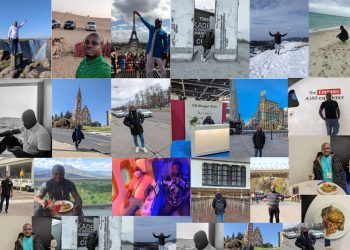The Northern part of Ghana is a key player in the tourism industry, boasting of several high profile and popular tourist sites which are well known across West Africa and the world at large. For the last two decades, the region has grown in leaps and bounds in terms of development meaning every year the number of visitors increases, resulting in increasing number of visitors to the sites the region has to offer travellers.
While you visit the region for business-related purposes, you may want to take advantage of your time there to visit some of the unique and incredible tourist sites in the region. To help you make the best choice, Jetsanza.com discusses the top attractions in the northern regions in this article.
Larabanga Mosque
The Larabanga Mosque located in Larabanga, in the West Gonja District is one of the oldest mosques in Africa and the oldest in Ghana built in the year 1421. While it has undergone several restoration and architectural works over the centuries, the core foundation of the building still remains intact and unchanged. The mosque also boasts of one of the oldest Qurans in the world believed by the people of Larabanga to have fallen from heaven in the year 1650 to the Imam at the time Yidam Barimah.
Mole National Park
With the largest wildlife refuge, Mole National Park has been an attractive site for many in the country due to its unique species. The current location of the Mole National Park was initially occupied by inhabitants of the Northern Region however they were relocated to pave way for the area to be used as a reserve. The famous animals that can be found at the Mole National Park are the African bush elephants and antelopes. A study conducted on the Park indicates over 800 elephants can be found at the Mole National Park. In terms of tree species Burkea Africana, Isoberlinia Doka, and Terminalia Macroptera are some of the species found in the forest.
While elephants and antelopes dominate the wildlife in the forest, animals such as buffalos, antelopes and hippos can also be found in the forest even though very small in terms of population. Monkeys have also made the Park their place of abode with the Olive baboons, black-and-white colobus monkeys, the green vervet, and patas monkeys all residing at the park.
Daboya
Daboya, located some 67kilometres northwest of Tamale and may not be a major household name in Ghana today, mostly due to the growth of commercial cities like Tamale and Wa in the northern part of Ghana. However, over a century ago, Daboya was probably the most popular town in the Northern region, famous for its mass production of salt and vibrant commercial activities.
Over a half of the salt consumption in Ghana in the 1700s and 1800s was supplied by Daboya as a majority of the women and men in the town were engaged in the salt mining business, making it one of the most active and commercially vibrant towns in Ghana. Today, Daboya can no longer be regarded as the salt hub of Ghana. While salt is still mined and produced in the ancient town, it is in lesser quantity compared to centuries ago, and the salt production today is only meant for the local market and consumption. The collapse of the Daboya salt market could be attributed to the desire for iodized and refined salt in the latter part of the 21st century. The change in preference of Ghanaians resulted in the importation of granulated and refined salt from Europe, killing off the Daboya salt market which supplied unrefined salt in its natural state. This has however has not stopped people from paying visits to the town to see the salt mining centres that once made Daboya a hugely successful commercial city in Ghana and West Africa. The gradual decline of the salt business in Daboya gave way to another craft in the form of fabric weaving. Today, the town of Daboya is more famous for its hand-woven traditional smocks than its production of salt. In fact, a majority of the fine handwoven smocks worn in the Northern region are produced in Daboya. While the town is not the most visited in terms of tourism, Daboya has the potential to become a major tourist destination in Ghana considering its rich and storied history, coupled with historical sites such as salt mines and handwoven fabric centres. Daboya may be on the brink of being forgotten, but its rich history is not lost.
The Mystic Stone
The Mystic Stone is located near the township of Damongo in the West Gonja District and lies about 6km from the famous Mole National Park and about 21km from Damongo. The stone first gained recognition in the 1950s when the British colonial administration embarked on a road project in the Damongo area where the stone was found. As part of activities to make way for the road project, a path on which the stone lied was cleared to make way for the work.
According to history, the contractors returned the following day only to realize the stone had mysteriously returned to its exact position from where it was cleared from. The contractors again cleared the stone from the pathway but returned the following day to once again realise the stone had returned to the spot where it had been moved from the second time. The authorities decided to let the stone remain there and find another path to create the road and since then, the Stone has been in the exact same spot without moving. This strange story behind the stone resulted in the indigenes naming the stone as the Mystic Stone, believing it possessed divine powers. Today, the stone is seen as more than a mere stone, with nearby town people using it as a worshipping spot where they go and pray to their ancestors for favour among other things. The spot has also become an important tourist attraction site in the northern region and attracts thousands of visitors each year, usually from other parts of the country.
Gbele Game Reserve
Gbele Game Reserve is one of the many wildlife reserves in Ghana, located in the Upper West region of Ghana. The facility is located close to the Burkina Faso border and lies approximately 90 km from the regional capital, Wa and 61 km from Tumu. Unlike most wildlife reserves in Ghana which have the vegetative nature of their forest to be tropical rainforest, the vegetative nature of Gbele forest is open savannah woodland, meaning rain here is limited and does not come frequently. The reserve is home to some of West Africa’s most popular wildlife animals such as the antelope, hartebeest, bushbuck, waterbuck, savannah duikers and warthogs, baboon, patas, green monkey and more, making it one of the most populous wildlife reserves in Ghana in terms of animal species and population. Birdwatching is another popular activity at the Gbele Game Reserve with the forest serving as home to more than 190 species of birds. Tourists who visit the centre usually make time to go for birdwatching to see these beautiful and amazing flying creatures that hangs on in trees. For the lovers of adventure, the reserve also gives tourist the chance to go for nature hikes and walks through the forest, visiting different sections of the reserve such as the rock outcrops.
The reserve also has tents for groups who wish to relax and spend the entire day at the park, as well as tour guides who are always on standby and ready to take visitors on a tour of the reserve.
Beyond the forest, one can also take a trip to the nearest township, Gwollu which is 30 km from the reserve. The town is home to some of the most historical monuments in the northern part of Ghana, such as the Gwollu slave defence wall which was built during the early 1900s and the tomb of former president, Dr. Hilla Limann.
Wa Naa’s Palace
The Waa Naa palace is one of the oldest traditional palaces in Ghana, built in the early 19th century to serve as the traditional resident of the king of the Wala people. The palace which is located in the heart of Wa, the regional capital of the Upper West region was built in ancient ancient Sudanese mud-brick architectural style, giving credence to historical accounts that suggests that the Wala people, who today dominate the Upper West region, originally migrated from the northern part of Africa, precisely Sudan.
Unlike most buildings, the walls of the palace have large visible y-shaped structures striking out of the walls. According to historical accounts of the Wala people, the nature of the walls was purposely to protect the people, especially the royal family from the incessant attacks of the slave traders.
More remarkably the magnificent structure built with mud-brick, still stands tall and strong without showing any signs of collapsing and continues to serve as political, religious and traditional symbol for the Wala people. The palace as was centuries ago, still serves as the royal home of the Wala paramount chief with royals from all the numerous clans that have once ruled the Wala chiefdom occupying the huge palace. More uniquely, the graves of former kings are found right in front of the palace. In 2009, the World Monuments Fund recognize the Y-shaped palace as one of the finest and last remaining ancient architecturally wonderful buildings that need preservation. To this, the organisation partnered with the Ghana Museum and Monuments board to make a device means of preserving the structure using traditional materials and processes in order not to destroy its ancient appearance. The project was successfully completed in 2012. Today, the palace is one of the most visited tourist attractions in the northern part of Ghana, receiving a great number of tourists every year.
Wechiau Hippopotamus Sanctuary
The Wechiau sanctuary is one of the many animal reserves in Ghana located in the Upper East region, precisely in the small town of Wechiau which forms part of the Lobi communities. The reserve is about 40 kilometre square in terms of land size and lies along the stretch of the Black Volta River, very close to Ghana’s boundary with Burkina Faso. Aside Hippopotamus which are the dominant animal population at the reserve, the park is also home to other wildlife animals including bats, chameleons, different species of snakes, lizards, and over hundred species of birds and butterflies.
Tourists who visit Wechiau Hippopotamus sanctuary also get the opportunity to ride in boats on the Black Volta which lays a few metres from the reserve and meet some friendly hippos in the river. This safari on the river is led by tour guards and boat drivers who are usually on standby waiting for visiting tourists to jump in and take the ride. The sanctuary also has a special lodge built in the town, where tourists who intend to spend more than a day at the site can spend the night at a small cost. During the night the tourists enjoy some local drinks like Pito with the town folks who usually gather around small fires to tell stories and enjoy the humming of the forest birds together. This is one of the best experiences for tourists who have lived their whole life in cities like Accra and Kumasi where such gatherings are not common or in existence at all. For the tourists whose main motive is to go and see the amazing hippos, the best time to visit the sanctuary is in the dry season, usually from August through November to January. This, however, does not mean there is no chance of meeting hippos if you go at any other time aside the specified periods. Tourists can also visit any time of the year and meet monkeys, bats, some colourful and rare bird species and even snakes.
Paga Crocodile Pond
All over the world, crocodiles are not to be one of the most vicious reptiles on the planet, blessed with the ability to fight and defeat almost any creature that comes their way. Its gracious jaws strikes fear into any creature that comes across it, including humans. To sum, it up, crocodiles are not the friendly type of creatures and will strike any living thing in its path with those powerful and fearsome jaws.
But in a small town in Ghana, known as Paga, located in the Upper East region of Ghana, a strange phenomenon exists where these powerful and vicious creatures have struck a love affair with humans beyond the understanding of nature. The crocodiles found in the famous Paga Pond popularly known as Paga Crocodile Pond, spend their days on the bank of the pond taking selfies with tourists and playing around.
Some adventurous tourists even go to the extent of sitting on the bank of the crocodiles to take pictures. All that has to be done to get the crocodiles to come out of the pond is for the tourist guide to whistle loudly. Once that is done you can expect the crocodiles to heed to the call and crawl towards the bank of the pond. There they take pictures and play around with the tourist who usually have to buy a chicken for the crocodile before the creatures come close to them.
Over the years, Paga Crocodile Pond has attracted millions of tourists from all walks of life. And there has never been an incident of a crocodile attack. The local folks have different stories about how these crocodiles landed in their small town, but generally, there is a belief among the town folks that the spirit of their ancestors reside in these creatures, who have strike an unprecedented love affair with the town folks and humans in general. So if you are curious enough, when planning on your next tourism adventure, Paga Crocodile is one place you wouldn’t want to leave out. The Paga town is located some 44 kilometres outside the regional capital, Bolgatanga.
Tongo Rocks and Tenzug Shrines
Tongo Rocks and Shrine are not among the most popular tourist destinations in Ghana, however, in the northern part of Ghana, it is a big deal and one of the most cherished and indigenous sites. Tongo is the capital of the Talensi-Nandam District in the Upper East region, located some 20km from the regional capital Bolgatanga. The town isn’t quite well known for its attraction of visitors or tourists but within the town lies the two potentially wonderful tourism sites in the name of Tongo Rocks and Tengzug shrine.
The Tongo rocks are found in the small village of Tengzug, a distance walk from the main town of Tongo. The Rocks are famous for their amazing and strange arrangement where one rock comfortably sits on one another in quite a fascinating form. The rocks are also known for making strange whistling sounds in Novembers and Decembers when the harmattan season kicks off. This has given the rocks the nickname the Whispering Rocks. Tourists can also view the entire landscape of Tongo and the entire region once they successfully scale the rocks and get to the summit of the rock. Another added bonus for scaling the rocks is the opportunity to visit the ancient Tengzug shrine found at the top of the rocks.
The shrine which now serves as the traditional religious home of Tongo was a secret hideout used by captured slaves who managed to escape during the invasion of the Europeans and trans-Atlantic slave trade era. Once at the shrine tourists are obligated to go topless by removing their shirts. After this, the tourists get to witness the performance of a sacrifice to the gods of the land. The sacrifice involves the slaughtering of fowls and birds by the priest of the shrine. Inside the shrine, tourists can also see remnants of sacrificed animals, bones and some traditional ornaments like beads and cowries. The people of Tongo are Talensis and the best time to visit is in March when the people are celebrating the Golob festival. Tourists can also visit in the month of October during the celebration of the famous Bo’araam festival which focuses on slaughtering animals and drinking beers.
Still have some travel questions? Ask in our Travel WhatsApp Group.







